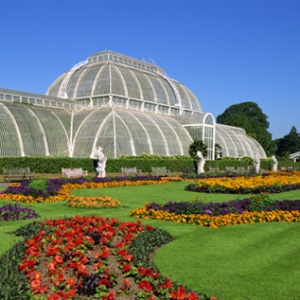Nick Johnson Public Glasshouses Manager, Royal Botanic Gardens Kew.
Credits
Interview by Gordon Parker
Production by Mike Johnston
Transcript by Jane Ford
Run time: 3:13
Transcript
Hello my name is Nick Johnson and I am the Public Glasshouses Manager and we are in The Royal Botanic Gardens, Kew.
The Palmhouse was built and it was opened by 1847. It was a masterpiece of architecture for its time and it was built to house the tropical collections of Kew. This is an example of one of the first.
So Kew has always been a bit of a way station. It was known as the hub for the British Empire so plants would come into Kew and then scientists would study them. We’d grow them here and then they’d say “right, we think this will do well for this industry over here or there” and then they’d be sent out.
It was probably black pepper that led the British to make their way round the Cape of Good Hope in the early 1500’s and set up a small colony on the western shores of India. That trade was probably the main reason why the British started their journey through India.
Here there is a 33.3ft roof so you can get things to their full size, get them to flower and fruit. The Latin for banana is musa and we have one that is called musa st helena. It is very likely that that is the variety of banana that was talked about in the 1830’s by the Governor of St Helena as being a very unique, very special tasting banana that had been brought from India by the British East India Company and had been planted on St Helena.
St Helena is an island down in the South Atlantic that was a bit of a way station on the way round the Cape to get up to India so all sorts of things were dropped off there to make sure that the sailors were provisioned on their way round The Cape.
It is a small banana and it is very very sweet. It is slightly spicy as well, it makes the backs of your cheeks fizz a little bit and it is a very special taste. It is one of those bananas that could be very important for us in the future.
Since the 1950’s Britain has been using one variety of bananas to provision our supermarkets which is called musa acuminata Dwarf Cavendish that is grown across the world. It is a clone, you don’t grow it from seed and all of these bananas that are grown across the world are clones of the original Cavendish banana that was found in south east Asia; so if there was a virus or disease, which there is, it could spread like wildfire across the globe and wipe out this commercial banana. It is important to keep old varieties going like this one so that we can replace the Cavendish with something else that is just as tasty.
Ends.
Thank you to Nick Johnson for taking the time to speak to us.
Royal Botanic Gardens Kew have worked with the following organisations to create special activities and surprises for Silk River:
The Royal Botanic Gardens, Kew is the world’s leading botanic garden, at the forefront of plant and fungal science, a UNESCO World Heritage Site and a major visitor attraction. It is home to the world’s largest collection of living plants and has over seven million preserved plant specimens for research. During the British presence in India it is known that many species were shipped back from Kolkata to Kew.
Through the Silk River project they hope to engage community groups, existing visitors and new audiences in learning about Kew’s unique links to India and Kolkata, through an enriching and exciting hands-on creative artistic experience.
They hope that the project will bring many local people together through walking, talking and creating a large-scale silk scroll that vibrantly captures and interprets the unique learning experiences of a fascinating journey around Kew Gardens, starting and finishing from the River Thames at Brentford Gate.







